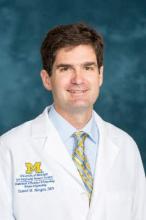ORLANDO – Financial penalties designed to induce hospitals with high surgical site infection rates to improve this aspect of quality of care are likely to be distributed unfairly, according to an analysis presented at the annual scientific meeting of the Society of Gynecologic Surgeons.
The plan, to be initiated in 2016 as part of the Hospital-Acquired Condition (HAC) Reduction Program of the Centers for Medicare & Medicaid, is to levy a 1% penalty for all hospitals that fall into the quartile with the greatest rate of surgical site infections (SSI), but only a proportion of these appear to be outliers, reported Dr. Daniel M. Morgan, an ob.gyn. at the University of Michigan, Ann Arbor.
Leaving aside the question of whether all hospitals in the bottom 25% for avoiding SSI are true outliers and, therefore, deserve a penalty, the study in Michigan suggested that the methodology proposed to rank SSI rates does not appear to be properly adjusted for risk.
In this study, SSI associated with hysterectomy was evaluated in 49 hospitals participating in a statewide surgical quality collaborative in which at least 10 hysterectomies were performed. Using data from the 16,000 hysterectomies in this database, hospitals were stratified by SSI rates using the National Healthcare Safety Network (NHSN) protocol (Infect. Control Hosp. Epidemiol. 2011;32:970-86). This is the methodology planned for the HAC reduction program.
While risk adjustment with the NHSN model was restricted to age, American Society of Anesthesiologists (ASA) class, surgical time, use of laparoscopy, and bed size, the Michigan initiative used a multivariate mixed logistic regression model to identify other factors found to significantly influence SSI rates. These included body mass index (BMI) >30, a gynecologic cancer diagnosis, and payment for services through Medicaid.
Using a quartile stratification, 12 of the 49 hospitals would warrant a penalty under the proposed HAC reduction program, but using the Michigan risk adjustment, 8 of these hospitals, or two-thirds of the total, would not have SSI rates significantly different from the mean and would be penalized unfairly.
Several of the hospitals changed quartiles when the Michigan risk adjustment methodology used the additional risk modifiers over those employed in the NHSN protocol. A change in ranking was more common in smaller hospitals relative to those with more than 500 beds, Dr. Morgan said at the meeting, jointly sponsored by the American College of Surgeons.
These data predict “some serious deficiencies in the planned protocol” that will result in “inappropriate targeting of some hospitals that fall into the bottom quartile,” Dr. Morgan said.
It is reasonable to target SSI rates as a strategy to improve quality of care, according to the SGS-invited discussant for this study, Dr. Kristen Matteson, an ob.gyn. at Brown University, Providence, R.I. She said that SSI is an important cause of morbidity and a significant driver of increased costs and it is appropriate to target those with ineffective or substandard processes for preventing infection. However, defining the outliers, “as demonstrated by these authors, it is a complicated process,” she said.
In an interview, Dr. Matteson suggested that it is not only developing a methodology for accurate risk adjustment but also confirming that the bottom 25% actually have rates that are clinically different than higher quartiles. Mathematically, there is always a bottom 25% on any scale, so it makes more sense to develop a cut-off that establishes true outliers rather than those that happen to fall in the bottom quartile.
These policies are going to be implemented soon, and data such as those in this study suggest that they may target hospitals that do not deserve to be targeted, Dr. Matteson said.
Dr. Morgan reported no relevant financial disclosures.


